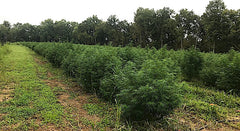
Organic Gardening vs. Synthetic Gardening
The organic growing vs. synthetic growing battle has been going on for decades amongst gardeners but recently, due to several high-profile articles on synthetic fertilizer's sometimes harmful effects on the environment, organic fertilizers have been making a comeback in the cultivation community especially amongst greenhouse cultivators and outdoor and indoor soil gardeners.
Depending on who you ask, an organic grower or a large, synthetic, cultivator, one is better than the other when it comes to yields, taste and overall effects.
To better understand the differences between these 2 different growing styles, let's start with a list of current, organic cultivation materials and methods and current, synthetic cultivation materials and methods.

(Photo: large, organic hemp farm in West Virginia, USA, 2019)
POPULAR ORGANIC CULTIVATION MATERIALS & METHODS:
Organic Media:
- Living soil
- Soil, bagged
- Native soil
- Soilless mix (soil, peat moss, perlite, pumice)
Organic Cultivation Methods:
- No Till
- Outdoor, tilled
- Greenhouse
- Light depravation greenhouse aka Light Dep
- Indoor, hydroponic
- Aquaponics (using live fish and their waste to feed plants)
Organic Nutrients:
- Liquid nutrients: can be applied via hand feeding, foliar spray or hydroponically using Suite Leaf Plant Nutrients
- Powdered, dry or crumbled nutrients: mixed in during transplanting or applied as a top dressing
- No nutrients, living soil only
POPULAR SYNTHETIC CULTIVATION MATERIALS & METHODS:
Synthetic Media:
- Rock wool (soilless, photo example below)
- Hydro clay (soilless)
- H2O*
- Soilless mix (same as soilless mix above except with inorganic materials such as newspaper, rock wool)
Synthetic Cultivation Methods:
- Indoor, hydroponically
- *DWC (Deep Water Culture)
- Greenhouse
Synthetic Nutrients:
- Liquid nutrients: can be applied via hand feeding, foliar spray or hydroponically using Suite Leaf Plant Nutrients
- Powdered or granular, water soluble, nutrients: mixed in during transplanting or applied as a top dressing. After initial feeding, mix with H2O and feed through, preferably, a reservoir system
Checkout all of our indoor gardening and home cultivation blogs here

